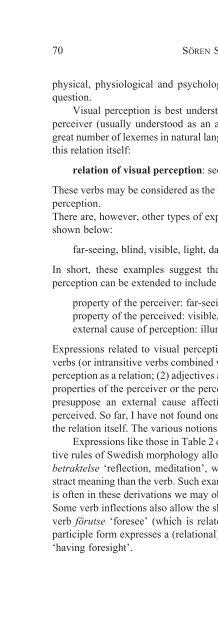Cognitive Semantics : Meaning and Cognition
Cognitive Semantics : Meaning and Cognition
Cognitive Semantics : Meaning and Cognition
Create successful ePaper yourself
Turn your PDF publications into a flip-book with our unique Google optimized e-Paper software.
Notes<br />
SPACE AND TIME 149<br />
1. In talking about sign languages, I distinguish between location <strong>and</strong> space such that<br />
location (or locative) is a semantic notion, while space denotes an expressive means of<br />
sign languages.<br />
2. An example such as<br />
(i) We’re coming up on Christmas. (from Lakoff 1993: 218)<br />
demonstrates the use of come to denote someone moving in time, but with ‘come’ used of<br />
‘later’ in time in apparent contrast to both (3a) <strong>and</strong> (4a). The point is, however, that in (3a)<br />
the event is seen from the point of view of the time when the door has been closed, in (i)<br />
the event is seen from the point of view of Christmas. In both cases the ‘coming’ is a past<br />
event in relation to the moment of the point of view, i.e. both demonstrate the conceptualization<br />
of time as stationary with someone moving along a path.<br />
3. Later in the article, Traugott uses Comrie’s (1976: 1-2) definition of tense, which differs<br />
significantly from her first definition: “Tense relates the time of the situation referred to to<br />
some other time, usually the moment of speaking.” (Traugott 1978: 374 - emphasis added).<br />
4. The transcriptions of signed examples in this chapter are very simplified. An English<br />
word in capital letters is a gloss for a manual sign. DET, the determiner, st<strong>and</strong>s for a<br />
pointing gesture that is part of a nominal, while PRON is a pointing gesture that functions<br />
as a pronoun. If a sign is modified, the modification is described by one or more words in<br />
small letters initiated by +: +deictic-tl-before means that the sign is modified for a locus<br />
indicating a moment in time earlier than the reference point. In the transcriptions, / st<strong>and</strong>s<br />
for a boundary marked non-manually or manually by lengthening of the sign preceding<br />
the boundary or by lowering of the h<strong>and</strong>s or the like.<br />
5. The overwhelming majority of temporal expressions using space in Danish Sign Language<br />
are static. One exception is an expression with a verb of motion modified for the<br />
deictic time line to denote the sudden <strong>and</strong> unexpected occurrence of an event (somewhat<br />
like Event X arrived suddenly <strong>and</strong> unexpectedly).<br />
References<br />
Benveniste, E.<br />
1974 Le langage et l’expérience humaine. E. Benveniste: Problèmes de linguistique<br />
générale II. Gallimard, 67-78.<br />
Brennan, M.<br />
1983 “Marking time in British Sign Language”. Language in Sign: An International<br />
Perspective on Sign Language ed. by J. Kyle & B. Woll, 10-31.<br />
London: Croom Helm.<br />
Bybee, J., Perkins, R. <strong>and</strong> Pagliuca, W.<br />
1994 The Evolution of Grammar: Tense, Aspect, <strong>and</strong> Modality in the Languages<br />
of the World. Chicago: The University of Chicago Press.















